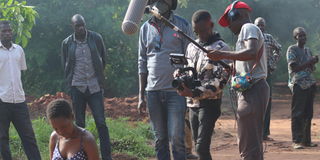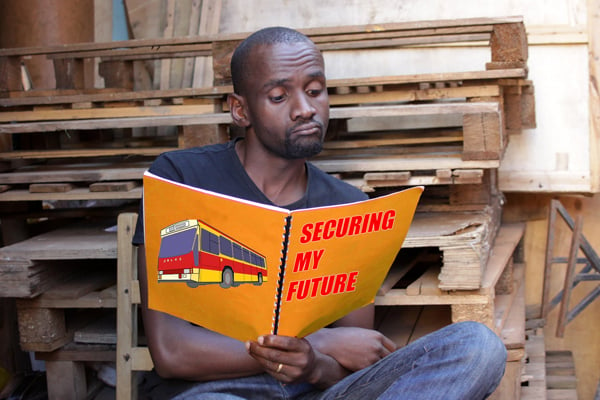Prime
Earning through the art of film that tells the stories on Gulu’s bitter past

Daniel Komakech (centre) directs a movie during a shooting in Gulu City. PHOTOS | EDGAR R. BATTE
What you need to know:
- Daniel Komakech attributes his commitment to the arts to the stability Taks Centre allowed them to have, first by being welcoming and then having enough spaces for them to perform and showcase their abilities. The biggest challenges he has faced has been access to funding and equipment.
While at university, there was a young lady who was mistreated by the landlord’s wife.
The lady was related to the landlord. In Daniel Komakech’s mind was the urge to expose the experience of the young lady and her story became the premise upon which his inspiration to make film was born.
Early life
Komakech went to school, pleased his parent with a degree but deep down, his heart continued beating for something else, other than the business degree he had acquired. He has a strong urge to tell stories through film, which allows him to relay experiences people would relate with.
His dream
His dream has taken him in circles and opened doors that has allowed him and his crew to tell the story of a war-torn area. It is based on the Lord’s Resistance Army (LRA) war against the Uganda People’s Defence Forces (UPDF).
Komakech was born in 1986, the year that ushered in the sitting government, and a month before the LRA launched an offensive attack on it. Today, he holds his camera, frames shots, and captures tales of those that experienced the attacks, first-hand, the girls who were raped and abused both in the bush by the rebels and in the shelters where they sought refuge from abduction when night fell, and rebels attacked.
Where would an innocent 12-year-old girl find solace in times when the clouds of hope gave way to hopelessness? The guns have gone silent but the emotional experiences of the pain they caused, remain freshly engrained.
Making money through film
Komakech tells such stories and is glad to enlighten the present and future generation through film as a lasting documentation of actual events. Filmmaking is his source of livelihood.
“We are a group of artists with different backgrounds such as photography, fashion, poetry, dance and film. We would work on different projects and showcase them at the TAKS Community Art Centre. With time, some grew and got jobs elsewhere. They still practice the arts but not as often as before,” says Komakech. He is less creative and director of United Youth Entertainment (UYE) a Community Based Organisation (CBO) which conceptualised this as part of the youth’s contribution to healing the wounds caused by the 20-year-old LRA war. The war devastated northern Uganda and Gulu in particular.
They use motion pictures (film) and other forms of art such as photography, poetry and spoken word, music, and dance to highlight community’s response to addressing major social and economic challenges that affect the youth and the society. For example the high prevalence of HIV/Aids among young people, Gender-Based Violence (GBV), high unemployment rates, promotion of culture, awareness about mental health issues and substance abuse among others.
His secret weapon
He graduated from Gulu University where, he majored in finance. He says it has enabled him to learn how to make business sense out of his job as a filmmaker; “Naturally, I know I have to make money out of this. If a client comes to me because of the track record, I make sure I quote for my services and make a living.” His cash cow is documentary filmmaking.

Daniel Komakech (left) and his film crew prepare a shoot.
“I have done documentaries for a number of Non-Government Organisations (NGOs) and that is where we have earned. Different clients have different budgets and needs. The goal is to do a good job and make a name,” the film maker says.
Employees
He employs two people on contract- an administrator and an assistant. When the job requires more hands, for instance field production, the youth group hires them on freelance basis. Most of those are film students that he will have trained. Komakech tells stories from within his community because he is familiar with his home area.
“When you tell stories from the community, you speak people who have actual experiences and that makes it easy to tell it the right way. And in sharing the stories through film, more people get to connect through experiences,” he says.
His products
He has produced more than 25 short stories and two feature films, and he has benefited from support from likeminded people and organisations, for example the Kuonyesha Art Fund through which he accessed a fund to shoot a movie titled, ‘The Night Commuter’.
It is focused on children who leave their homes in the evening for fear of abduction from the LRA rebels, spend a night in Gulu town and then return to their homes at daybreak. He explains; “Some of the girls would be abused and taken advantage of in the shelters that is what I focus on. So far, I have done the first two cuts and I am finalising on the sound and picture. My goal is to finish the film by the end of March because I want to submit it to the Uganda Film Festival (UFF),” he shares.
The other feature films are The Girl from Lamwo’ whose story is anchored on his aunt’s experience who comes from the village to town and is overwhelmed by what she finds, and then ‘Let’s do it’ which is about the test of character between two friends who are faced with a challenge. Komakech chose to start making films at a time when the art had not caught on in Gulu, so he ended up taking on a lot, a ‘one crew person’, an experience that led him on a learning sojourn. “I learnt how to write, edit, camerawork and producing,” he says. He has narrowed down to producing because people will come from the community, Kampala and beyond with ideas that they need to put to life and that has become his forte.
Film school
With film and showcasing the art of motion picture, the 35-year-old envisions starting a film school. Now, the interest to learn film attracts students from neighbouring districts such as Kitgum. “Some people call us from West Nile. The goal right now, with the training programme, is to set up a film school and then a studio alongside it. Those are two elements missing in the film sector in this region,” says Komakech.
To the policy makers in government, he is aware that less than 20 percent of them are implemented. But, if they were, it would ease the craft of making film.
Film as business
The need to sensitise parents and guardians about the importance of film as a business, art and a potential source of livelihood to youngsters, is important.
He and fellow artists have led in the campaign though radio shows, to amplify the need to use film as a platform to tell stories and share experiences.
And to you who is looking at cutting teeth as a filmmaker, be patient. “It will not happen in a day or two. Film is broad. You need to focus on something and learn how to do it well. It is important to know all the others too; writing, editing, producing and more,” he says. He has mentored people into the art. “People will come to me because of the small success I have had. Many think it took me a day, but I tell them that it is about sacrifice in terms of time, money and distance from family,” he advises.
“Are filmmakers born or made? I ask. His response is it takes a bit of both or just one. “It starts with a personal decision to become a filmmaker then you can get training l. I got training but I also taught myself,” he explains.
Best moment
The best advice anyone has given him was to stick at it, at doing film. When he started his journey, he had many artist friends from different art disciplines.
With time, a few moved on to double the arts with day jobs. He stayed the course. As the circled narrowed, he started film production as a niche which was popular among many young people.
No regrets
Film training was done at the Gulu International Film Festival. 10 years later, Komakech has no regrets but is optimistic at achieving more.
In his earlier career, Komakech was shooting, editing, and producing music videos. In 2009, he began his journey as a filmmaker. His baby steps started with him researching about how to write stories which he later learnt to turn into scripts. All that was on Google and YouTube tutorials. In 2011, there was a film and photography training opportunity organised by a group of creatives from Madrid, Spain called Hypo Heals who had partnered with a CBO called Youth Photography Outreach.
The training was about writing, basics of camera use and building stories. It took place at Pece Stadium in Gulu City.





